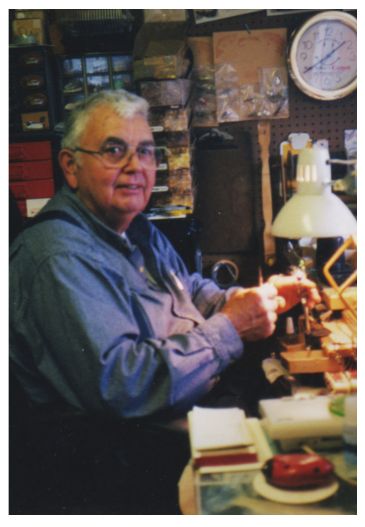
Oct. 26, 1936-Nov. 6, 2014
A fisherman’s friend
Catching fish takes patience. Knowledge. And lures – lots of lures.
By those standards, Robert “Bob” Folder had it all. Thanks to him, Springfield became known worldwide as a source for some of the best lures on the planet.
His shuttered workshop on the west edge of Springfield is filled with feathers, hooks, completed lures and photographs of ecstatic customers grinning as they hoist behemoth salmon, trout, crappie and other species.
“Hell-of-a-jig Bob!” scrawled a man pictured with an oh-my-god northern pike.
There are two letters from Jimmy Carter, thanking Folder for lures sent gratis after the two met during an Atlanta sporting goods show.
“I will make use of them all, and especially look forward to trying the Goofus Bug,” the former first fisherman wrote in a 1981 message.
Folder’s was a business built on passion, hard work and, ultimately, his reputation. He started tying flies full time in 1977 and peddled them, mainly to wholesalers, at sporting goods shows throughout the nation. He worked until 2012 and never had a website.
“That’s what everyone would say: ‘Do you have a web page?’” recalls his widow, Mary.
He didn’t need one, nor could he meet demand for his lures by himself. And so he trained people to tie streamers and jigs, paying by the piece, while he created more complicated flies himself. His selftaught style was a bit unorthodox, and he refused to hire anyone with experience so that they would do it his way. He preferred women, whom he judged to have more nimble hands than men. As many as 30 people worked for him at a time, most from their homes, churning out thousands of lures each day.
Bob Folder Lures were not always the prettiest in the tackle box, and he didn’t care that the dull side of a feather was more visible on his flies than the shiny side. Flies tied his way, he insisted, looked more natural to a fish, which he considered more important than looking good.
“Most flies on the market are tied with the feathers’ shiny side forward,” he told Dave Ambrose, managing editor for the state Department of Conservation’s magazine called Outdoor Illinois in 1982. “That may look flashier, but it catches more fishermen than fish.”
Strictly speaking, Folder wasn’t a born fisherman, but he was on the water by age 3. He was more obsessed than avid, going so far as to take his future wife fishing on dates after the couple met in high school at the long-closed Moonlight Gardens skating rink where Shop ’n’ Save now stands at the western edge of Jerome.
As a boy, Folder fished whenever he could for bluegill in Lake Springfield. One day, the fish wouldn’t bite, and so Folder wrapped a bit of chenille pipe cleaner around a hook. Just like that, the fish started biting, and so was born a flytying superstar. He always felt the magic.
“Fly tying is an art that I hope never gets lost in the shuffle,” Folder said in the 1982 interview. “It’s a real thrill to make something and then go out and catch fish with it.”
Banana-pink head pearl tinsel jig.
Yellow bass retriever. Bob’s ice spoon. Turbo buzz bait. All told, Folder created some 600 different types of flies and lures, most selling for less than $5 apiece. He mailed unique designs to himself, then placed the unopened envelopes in a safe deposit box, which he referred to as a poor man’s copyright. No one was ever sued.
Folder was always good with his hands, getting work as a welder after graduating from Feitshans High School. Drafted into the Army four years later, he came home to Springfield in 1962, where he promptly got a job as a glazier at the Capitol Glass Co.
As a glazier, Folder was good enough that he was tasked with repairing and replacing leaded glass at headquarters for the Thomas Publishing Co., which is known today as the Dana-Thomas House. His wife, Mary, recalls that his employer sent no one else to take care of the windows in the historic home designed by Frank Lloyd Wright that is now a tourist destination owned and operated by the Illinois Historic Preservation Agency. As a fly tier, Folder pumped out imitations of all manner of insects, including tiny midges that he created from strands of deer hair tied to hooks the size of pencil erasers.
“It takes a ton of patience to sit all day,” Mary Folder recalls. “He had an extreme amount of patience.”
Folder, who favored trout fishing in Montana, didn’t consider fishing to be a particularly complicated undertaking.
“To be a successful fly fisherman, all you really have to do is take a (fake) moth or beetle, throw it in the water and imitate the way a real one would act,” he told Ambrose in 1982. “It’s that simple.”
Despite offering hundreds of different designs, he told the Illinois State Journal in 1976 that a fisherman who uses one lure constantly will catch his share of fish, but most anglers keep trying different things.
“Take one lure, and use it enough, and you’ll catch,” he advised.
Contact Bruce Rushton at [email protected].